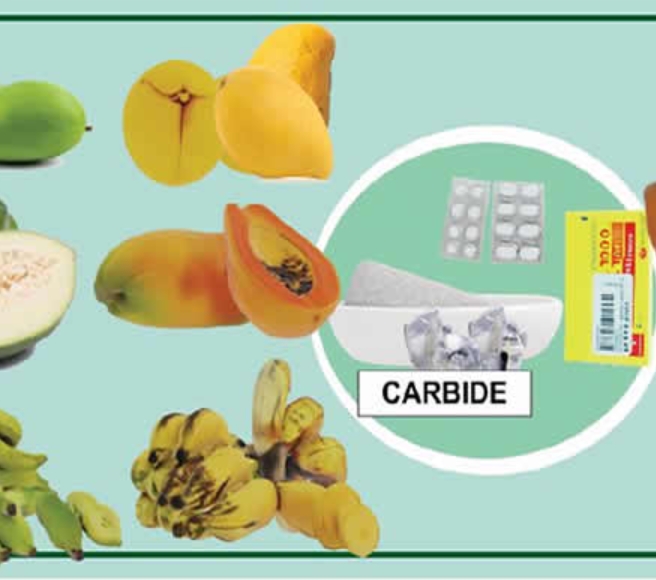Headline
How Combination Of Paracetamol, Carbide For Ripening Fruits Compromises Health

Artificial ripening is commonly employed to make fruits market-ready quickly, especially in regions with poor cold-chain infrastructure.
Chemicals such as calcium carbide and, more recently, paracetamol, have been found to be used in this process.
Research shows that these chemicals release heat when activated, creating conditions that mimic natural ripening. However, this process often introduces toxic substances into fruits, posing health risks to consumers.
A study by Mouli Chandar and Anton Smith from the Department of Pharmacy, Faculty of Engineering and Technology at Annamalai University, in Chidambaram, India, reviewed the artificial ripening of bananas, examining its physicochemical changes, benefits, and harmful effects.
Their research examined the effects of various ripening methods, including natural ripening, fumigation, exposure to heat, and the use of substances like calcium carbide, ethylene, and methyl jasmonate.
The study found that natural ripening yields beneficial effects without toxicity, while stress-induced or chemically induced ripening alters active components, potentially leading to physiological dysfunction in humans.
Negative risks
Using paracetamol to artificially ripen fruits such as bananas and plantains has become a significant health concern in Nigeria.
Health and nutrition experts warn that this practice is hazardous due to chemical alterations and the risks it poses to the food chain.
Paracetamol, also known as acetaminophen, contains active compounds such as para-aminophenol derivatives, which exhibit mild oxidative properties.
When exposed to heat or specific environmental conditions, these compounds break down into by-products that can accelerate the ripening process by stimulating the release of ethylene gas, a natural plant hormone responsible for ripening.
However, the misuse of paracetamol in ripening alters its chemical composition, leaving harmful residues on fruits. Fruits ripened with paracetamol may retain toxic by-products, which, over time, can lead to liver and kidney damage as the body struggles to process these excessive and unnatural chemicals.
According to a health researcher based in Europe, Temitope Fadeyi, the breakdown of paracetamol under heat can produce harmful compounds such as aniline, which is potentially carcinogenic and increases the risk of cancer with prolonged exposure.
READ ALSO: NAFDAC Issues Warning To Bakeries Over Saccharin, Bromate Usage
This process also compromises the nutritional quality of fruits, reducing their vitamin content and altering their sensory characteristics.
Additionally, frequent consumption of such fruits can cause acute symptoms such as nausea, vomiting, and abdominal pain, as well as chronic conditions like organ damage.
A nutritionist and dietician, Mrs Ngozika Nnam, noted that this process can also lead to hormonal disruptions.
She noted that certain chemical by-products may act as endocrine disruptors, potentially affecting hormonal balance, fertility, and development in consumers, including children and pregnant women.
Nnam also said that the unnatural ripening process often results in fruits losing essential vitamins and micronutrients, particularly vitamin C, which deteriorates due to chemical exposure.
The nutritionist added that consuming large quantities of fruits ripened with paracetamol can as well bring about symptoms of acute poisoning, such as nausea, vomiting, abdominal pain, and even liver failure in severe cases.
She noted, “The improper disposal of used paracetamol tablets and the chemical residues left on fruits can also contaminate soil and water sources, creating environmental hazards.”
Safer alternatives to artificial ripening
Experts have noted that there are several safer alternatives to ripening these fruits than using harmful substances. and according to Nnam, one of them is natural artificial ripening.
She said, “The ripening process is carried out using natural ripening agents and methods (without the aid of chemical substances).
“Example is ripening by fumes, increasing the ripening rate by placing in a closed container, and placing fruits like apple, avocado, etc., along with unripe bananas promotes ripening to a greater extent.”
She affirmed that the natural method was the best.
“This simple method practised in the household is meant to trigger ripening and to keep the unripe fruit inside an airtight drum containing rice or wheat.
“The fruits stored in such a way ripen quickly because of the accumulation of ethylene gas and the self-heating nature of grains. Rice and wheat grains differ in their seed dormancy, which affects the seed respiration rate.
READ ALSO: NAFDAC Demands Full Compliance With Sachet, PET Bottle Alcohol Ban
“Respiration of rice or wheat grains produces carbon dioxide, which induces ethylene biosynthesis in several fruits. Since respiration is higher in rice than in wheat, unripe fruits placed in rice ripen faster than those in wheat.
“Another alternative is spreading unripe fruits in layers over paddy husk or wheat straw for a week to ripen,” she explained.
A public health researcher, Grandeur Malite, shed light on an experiment where various packaging materials—plastic bags, poly sheets, wooden boxes, and open-air (as a control)—were combined with natural ethylene sources such as avocado, mango, and tomato were used for fruit ripening. He noted that they were tested as two factors, explaining, “One packaging material contained one plant ethylene source at a time, with equal weights of the three ethylene sources used separately for each. This created 12 treatments with three replications, resulting in 36 experimental units. Samples of unripe bananas were placed in each unit.
“The results showed that bananas placed with avocado ripened first in six days, followed by tomato in 6.5 days and mango in 7.1 days.
“In terms of containers, bananas placed in a wooden box ripened fastest, while those in a poly sheet took the longest time. Based on this experiment, using avocado in combination with a wooden box provides the shortest ripening period without compromising the quality of the fruit,” he concluded.
Regulatory concerns and public awareness
The National Agency for Food and Drug Administration and Control in Nigeria had severally raised concerns over the use of unsafe artificial ripening agents, including paracetamol, calcium carbide, and other dangerous chemicals.
NAFDAC warned about the inherent health risks and called for increased public education on the dangers of these practices while urging stricter regulatory actions against offenders.
The Director-General of NAFDAC, Prof Moji Adeyeye, who was represented by the Director, Chemical Evaluation and Research, Dr Patrick Omopariola, while speaking during a sensitisation workshop tagged, “Dangers of drug hawking and ripening of fruits with carbide” organised in 2023, urged Nigerians to stop eating fruits ripened with chemicals.
She said that the ignorance of safe methods had made many people to adopt unhealthy practices, which had caused health issues and claimed several lives.
“There have been clarion calls by well-meaning Nigerians on the need to take stringent regulatory actions to stem the dangerous tide of drug hawking and ripening of fruits with calcium carbide.
“In addition, several national dailies and non-governmental organisations have raised concerns on the looming danger and health implications of these two nefarious activities by certain unpatriotic and unscrupulous citizens in our country,” she said.
The NAFDAC boss charged participants to assume the role of champions in the vanguard of the campaign against drug hawking and the use of calcium carbide to ripen fruits, as well as other unsafe practices of food preservation.
She also said that the menace of drug hawking posed a serious challenge to the healthcare delivery system in the country and underscored NAFDAC’s resolute determination to totally eradicate the unwholesome practice.
READ ALSO: NAFDAC Warns Nigerians Of Fake Anti-malaria Drugs In Circulation
“Drugs are sensitive life-saving commodities, which should not be sold on the streets, in motor parks, or open markets, just like any other article of trade.
“I wish to warn that any drug hawker arrested by NAFDAC will be prosecuted and our enforcement officers are currently carrying out a synchronised nationwide operation.
“No offender will be spared from facing the full wrath of the law,” Adeyeye said.
According to Adeyeye, drug hawkers are also the major distributors and suppliers of narcotics to criminal networks, such as bandits, insurgents, kidnappers, and armed robbers.
“Drug hawkers constitute a serious threat to our national security,” she further said.
In a personal remark, Omopariola said that the dangers of using artificial methods to ripen fruits include loss of vitamins and micronutrients, adding that consumption of dangerous chemicals, such as arsenic, is carcinogenic, and that phosphorus, can lead to health issues and death.
He identified Calcium Carbide, Acetylene, Ethephon, Ethylene, and Ethylene glycol as the five most commonly used artificial ripeners in the country.
According to him, there are safe alternatives and Nigerians should embrace them.
In a presentation, the Director of Food Safety and Applied Nutrition in the agency, Mrs Eva Edwards, highlighted the dangers of food fraud and its impacts on public health.
He said that at least 200,000 Nigerians, including pregnant women and children under five, die annually from consuming contaminated food, hence the need for awareness creation on food safety.
Also, in July 2020, the Deputy Vice-Chancellor (Research, Innovation, and Strategic Partnerships), University of Ibadan, Professor Adenike Adeyemo, warned that many of the toxic chemicals added as preservatives are not safe for human consumption.
The professor of Aquatic Epidemiology and Toxicology, declared that the perpetrators are ignorant of the health implications of the act and tend to get away with the atrocity because the quantity of the poison added is small and usually takes a long time before its side effects are noticed.
Although Nigeria lacks statistics on the health effects of these toxic preservatives in foods, the academic said, “There is an increase in diseases such as cancer, birth defects, kidney failure, and diabetes in children. These diseases don’t just happen.
READ ALSO: NAFDAC Shuts 10 Bakeries, Eight Water Factories In Rivers
“It is a function of what an individual breathes in or eats.”
According to her, toxic preservatives have cumulative effects on the body, even though they do not kill immediately when consumed.
“It is something that we need to take more seriously. It is something that is very scary. As humans, our body mass is large and the quantity that we eat is not massive, so we would not die immediately or know that these things are causing harm.
“By the time the effect, kidney or liver problems, or cancer, starts to show—maybe 10 or 15 years after—nobody will link it to what was eaten in the past.”
Also, the Director of Drug Metabolism and Toxicology Research Laboratories, University of Ibadan, Professor Olatunde Farombi, stated that although the practice of adding toxic preservatives to food items, including fish, vegetables, and fruits, is common, it is not official.
According to him, while many traders use carbide to ripen fruits such as oranges, mangoes, and bananas to preserve them, some spray chemical compounds like Sniper, a brand of pesticide, on beans to prevent weevils from infesting them.
Farombi said, “These practices are illegal. All these chemicals can affect a wide range of body systems and cause liver failure, cancer, kidney failure, and brain damage. Can you imagine people using an old tyre to roast a cow? The tyre contains a lot of toxic substances that can contaminate the meat.
“Some people use formalin, a chemical used to preserve corpses in the morgue, to preserve fish in cold rooms before eventually selling them to people for consumption.”
Preventive measures
Experts have noted that education, tighter regulation, and safer practices would help to solve this problem.
A food safety expert, Samuel Essien, noted, “Public awareness campaigns can educate farmers and sellers about the dangers of using chemicals for ripening.
“Stronger food safety regulations, including testing of fruits for chemical residues, are crucial. Encouraging traditional ripening methods and providing safer, regulated ripening agents can mitigate these risks.”
He added, “It is evident and already proved by many researchers that the use of chemical agents such as calcium carbide, ethephon, ethylene glycol, calcium chloride, and inducing ripening by fumes from kerosene is highly hazardous and may be fatal if consumed.
“It is always best to use naturally induced methods of artificial ripening by placing bananas with avocado, apples, etc., or by using fumes from dried leaves or straws.”
PUNCH
Headline
Aircraft Crashes In Owerri With Four Persons Onboard

A Cessna 172 aircraft with registration number 5N-ASR, operated by Skypower Express, has crashed at the Sam Mbakwe International Cargo Airport, Owerri, Imo State.
The aircraft had departed Kaduna International Airport en route to Port Harcourt International Airport before diverting to Owerri after the crew declared an emergency.
The crash occurred at about 8:00 pm on the airport premises, with four passengers and crew members onboard.
Confirming the incident, the Director, Public Affairs and Family Assistance of the Nigerian Safety Investigation Bureau (NSIB), Mrs. Bimbo Oladeji, said the agency had been notified of the crash.
READ ALSO:Social Media Feud Spills Into Aircraft As VDM, Mr Jollof Exchange Blows
According to the NSIB, the aircraft crashed on the approach area of Runway 17, but no fatalities have been recorded so far.
The statement said: “Following the occurrence, airport emergency services were successfully activated and arrived on site promptly. Reports indicate that there was no post-crash fire, and the runway remains active for flight operations, with other aircraft taking off safely after the incident.
“Efforts are currently underway to coordinate the recovery and evacuation of the distressed aircraft from the crash site to allow for a detailed wreckage examination.”
The NSIB said it has officially activated its investigation protocols in line with its statutory mandate
READ ALSO:Ogun To Prosecute DJ Over Multiple Road Crashes
The Director-General of NSIB, Capt. Alex Badeh Jr., sympathised with the management of Skypower Express over the incident and expressed relief that no lives were lost.
Badeh Jr. added that the Bureau’s investigation team is already coordinating with relevant authorities to secure the crash site and commence a detailed investigation into the cause of the accident.
Two days ago, 11 persons narrowly escaped death as a private jet crash-landed at Mallam Aminu Kano International Airport, Kano, on Sunday morning.
The occupants, including passengers and cabin crew, were safely evacuated amid an intense atmosphere, eyewitnesses told The Guardian.
READ ALSO:Tanker Crash Kills Three, Fire Razes Shops In Kano
The private jet, owned by Flybird Aviation, crash-landed at about 9:30 a.m. while approaching Kano Airport en route to Abuja.
The incident attracted urgent attention, with emergency staff and other stakeholders converging at the runway to render rescue operations.
The management of the Federal Airports Authority of Nigeria (FAAN) is yet to release an official statement on the incident. Unofficial sources disclosed that the passengers have been taken to an unknown destination.
Several aircraft incidents have occurred at Kano Airport, with several lives lost.
The last incident occurred in May 2002, when an EAS Airline aircraft departed the runway at Aminu Kano International Airport at 1:29 p.m. local time en route to Lagos.
Headline
Musk Breaks Record As First Person Worth Over $600 Billion

Elon Musk, Chief Executive Officer of SpaceX, Tesla, and xAI, has reached a new personal wealth milestone, surpassing a net worth of $600 billion, driven primarily by a recent valuation increase of SpaceX.
The development makes Musk the first individual in history to exceed the US$600 billion threshold.
According to Bloomberg’s Billionaires Index, Musk’s net worth stood at approximately $638 billion as of 15 December 2025, with the increase largely attributed to SpaceX, which was recently valued at around $800 billion following an insider share sale.
The privately held aerospace company, based in Starbase, Texas, is now considered the most valuable private firm globally, significantly boosting Musk’s personal holdings.
READ ALSO:Elon Musk Joins ‘Cancel Netflix’ Campaign
Musk’s stake in Tesla, estimated at roughly 12 per cent, is valued at nearly $200 billion, while his majority ownership of xAI Holdings is estimated at $60 billion.
Collectively, these assets place him on track to potentially approach US$700 billion, widening the gap between him and the world’s second-richest individual, former Google CEO Larry Page, valued at $265 billion.
The SpaceX valuation comes ahead of a projected public listing in 2026, which could see the company valued at approximately $1.5 trillion.
“Other shareholder meetings are snooze-fests but ours are bangers. Look at this. This is sick,” Musk said in November during Tesla’s shareholder meeting, referring to a performance-linked pay package approved by investors.
READ ALSO:EU Fines Elon Musk’s X €120m For Violating Digital Content Rules
He added, “I super appreciate it.” The package, potentially worth up to US$1 trillion in stock, is tied to market-capitalisation and operational milestones over the next decade.
SpaceX’s Starlink satellite network has also contributed to investor confidence. The company continues to expand high-speed internet access to underserved regions worldwide.
Chad Gibbs, Vice President of Starlink Operations, stated that the satellite technology “bypasses the need to build massive amounts of infrastructure,” allowing broader and faster connectivity.
Musk’s ascent in personal wealth follows years of strategic risk-taking and long-term planning, with Tesla’s focus on electric vehicles, battery technology, and autonomous systems laying the foundation for his financial growth.
Analysts note that the combination of SpaceX’s soaring valuation, Tesla’s long-term incentives, and Musk’s diverse portfolio underpins his current status as the world’s wealthiest individual.
Headline
South Korea, Japan Protest China, Russia Aircraft Incursions

South Korea and Japan reacted furiously on Wednesday after Chinese and Russian military aircraft conducted joint patrols around the two countries, with both Seoul and Tokyo scrambling jets.
South Korea said it had protested with representatives of China and Russia, while Japan said it had conveyed its “serious concerns” over national security.
According to Tokyo, two Russian Tu-95 nuclear-capable bombers on Tuesday flew from the Sea of Japan to rendezvous with two Chinese H-6 bombers in the East China Sea, then conducted a joint flight around the country.
The incident comes as Japan is locked in a dispute with China over comments Prime Minister Sanae Takaichi made about Taiwan.
READ ALSO:China Backs Nigeria, Warns Against Foreign Interference
The bombers’ joint flights were “clearly intended as a show of force against our nation, Defence Minister Shinjiro Koizumi wrote on X Wednesday.
Top government spokesman Minoru Kihara said that Tokyo had “conveyed to both China and Russia our serious concerns over our national security through diplomatic channels”.
Seoul said Tuesday the Russian and Chinese warplanes entered its air defence zone and that a complaint had been lodged with the defence attaches of both countries in the South Korean capital.
“Our military will continue to respond actively to the activities of neighbouring countries’ aircraft within the KADIZ in compliance with international law,” said Lee Kwang-suk, director general of the International Policy Bureau at Seoul’s defence ministry, referring to the Korea Air Defence Identification Zone.
READ ALSO:Trial For South Korean Woman Accused Of ‘Suitcase Murders’ Starts Today
South Korea also said it deployed “fighter jets to take tactical measures in preparation for any contingencies” in response to the Chinese and Russian incursion into the KADIZ.
The planes were spotted before they entered the air defence identification zone, defined as a broader area in which countries police aircraft for security reasons but which does not constitute their airspace.
Japan’s defence ministry also scrambled fighter jets to intercept the warplanes.
Beijing later Tuesday confirmed it had organised drills with Russia’s military according to “annual cooperation plans”.
READ ALSO:South Korean Actress Kim Sae-ron Found Dead In Seoul Apartment
Moscow also described it as a routine exercise, saying it lasted eight hours and that some foreign fighter jets followed the Russian and Chinese aircraft.
Since 2019, China and Russia have regularly flown military aircraft into South Korea’s air defence zone without prior notice, citing joint exercises.
In November last year, Seoul scrambled jets as five Chinese and six Russian military planes flew through its air defence zone.
Similar incidents occurred in June and December 2023, and in May and November 2022.
READ ALSO:Russia Insists Ukraine Must Cede Land Or Face Continued Military Push
Meanwhile, Tokyo said Monday it had scrambled jets in response to repeated takeoff and landing exercises involving fighter jets and military helicopters from China’s Liaoning aircraft carrier as it cruised in international waters near Japan.
It also summoned Beijing’s ambassador after military aircraft from the Liaoning locked radar onto Japanese jets, the latest incident in the row ignited by Takaichi’s comments backing Taiwan.
Takaichi suggested last month that Japan would intervene militarily in any Chinese attack on the self-ruled island, which Beijing claims as its own and has not ruled out seizing by force.
AFP

 Metro4 days ago
Metro4 days agoSuspected Kidnappers Abduct 18 Passengers On Benin-Akure Road

 News4 days ago
News4 days agoI’m Not Distracted By Anti-Niger Delta Elements, Says PAP Boss, Otuaro

 News4 days ago
News4 days agoOPINION: Time For The Abachas To Rejoice

 News5 days ago
News5 days agoEdo Assembly Charges Contractor Handling Ekekhuan Road To Accelerate Work

 Sports3 days ago
Sports3 days agoJUST IN: Dembélé Named FIFA Best Men’s Player, Bonmatí Wins Women’s Award

 News3 days ago
News3 days agoWage Dispute: Court Orders PSG To Pay Mbappe €61 Million

 Headline3 days ago
Headline3 days agoAircraft Crashes In Owerri With Four Persons Onboard

 Metro4 days ago
Metro4 days agoNDLEA Seizes 457kg of Cannabis, Arrests Suspected Trafficker In Edo

 Business3 days ago
Business3 days agoCBN Revokes Licences Of Aso Savings, Union Homes As NDIC Begins Deposit Payments

 News4 days ago
News4 days agoEx-Nigerian Amb., Igali, To Deliver Keynote Address As IPF Holds Ijaw Media Conference


























